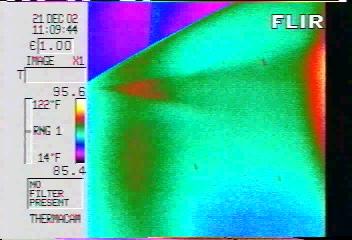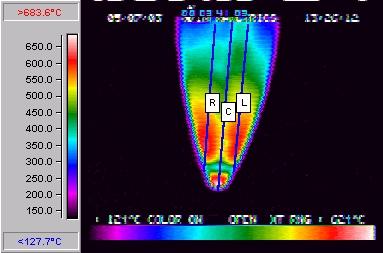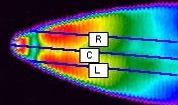|
IR Thermography
IR Thermography is a real-time, non-intrusive surface temperature measurement technique, used for measuring global surface temperature, heat flux, emissivity, flow separation and transition.

Separated flow at supersonic conditions
Applicability:
- Use of thermal imaging for aerothermodynamic measurements and detection of flow separation and transition
- Highly useful for CFD validation

Aero-heating of missile nosecone
Facility Requirements for Infrared Thermography:
- Optical access to model required. Might require the use of infrared transmitting windows.
- Minimize sources of infrared radiation in the test section to prevent reflections on model.
- The flow medium must be able to transmit infrared radiation.
- Able to provide a step change in the free-stream temperature (for flow transition detection).
Model Radiometric & Thermophysical Property Requirements:
- High emittance (minimize reflections).
- Low thermal conductivity (minimize thermal conduction losses).
- Low specific heat (maximize temperature change).
- Region of interest should be viewed along its normal vector (minimize directional emittance errors).
Benefits of Infrared Thermography:
- Real-time global temperature measurement technique.
- Non-intrusive.
- Large dynamic temperature range (-50°C – 2000°C)
- High accuracy (MRTD < 0.1°C)
- A proven technique.
Limitations of Infrared Thermography:
- May be difficult to get "good" data from models with less than optimal thermophysical & radiometric properties (i.e. high thermal conductivity, low emittance, & high specific heat).
- May require infrared transmitting optics.
- Current camera technology not suited for very low temperature applications (< -50°C).
- Reduction and interpretation of thermographic data can be complex.
- Laboratory quality radiometric systems can be expensive.
Facilities Infrared Thermography was used Successfully:
- Basic Aerodynamics Research Tunnel
- Low Turbulence Pressure Tunnel
- 8-ft High Temperature Tunnel
- 31-in Mach 10 Tunnel
- Unitary Plan Wind Tunnel
- Gas Flow Calibration Tunnel
- White Sands Missile Range
- High Intensity Radiated Fields Lab Reverberation Chamber
|




